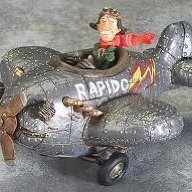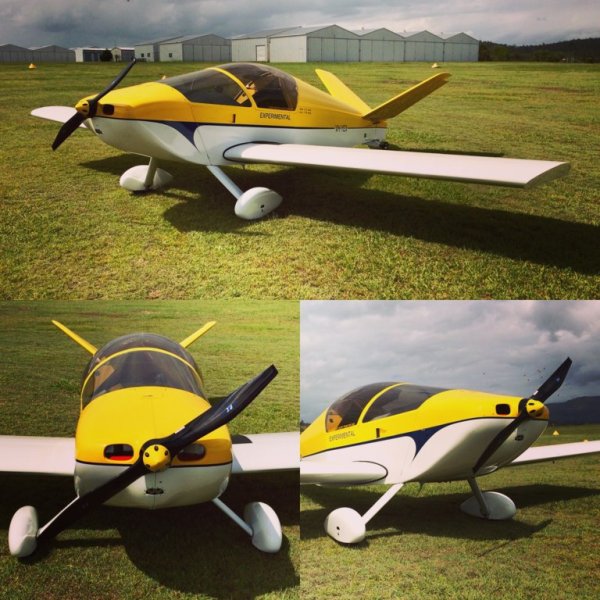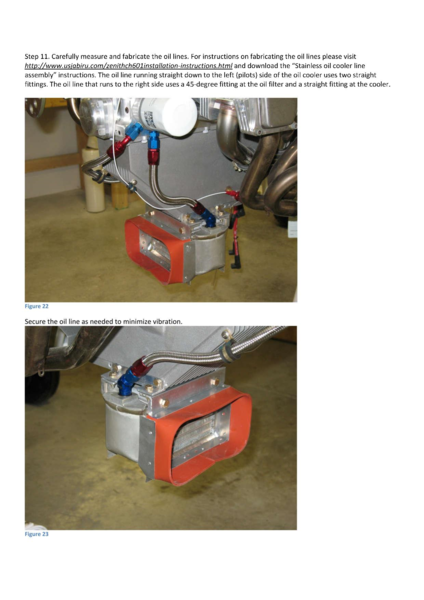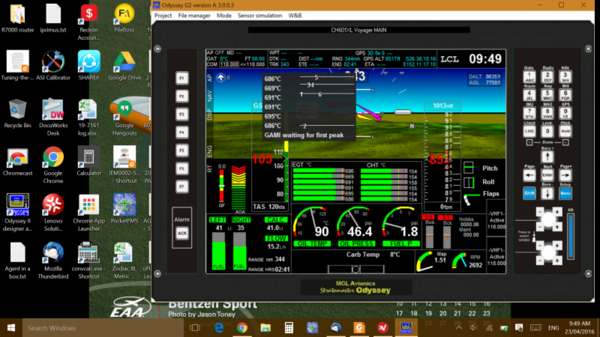-
Posts
260 -
Joined
-
Last visited
-
Days Won
2
Content Type
Profiles
Forums
Gallery
Downloads
Blogs
Events
Store
Aircraft
Resources
Tutorials
Articles
Classifieds
Movies
Books
Community Map
Quizzes
Videos Directory
Everything posted by dlegg
-

EASA certification of Rotax 915 (Now 141 HP)
dlegg replied to Downunder's topic in Engines and Props
Dont forget to add in the cost of a FWF setup, also exhaust is not included so install costs can rise a further 10k plus. So at least 65k on a new install or retrofit. -
Your temps are pretty good. Perhaps you might have to go one size up on the main jet over the winter.
-
It does look like engine failure. The prop in the vertical position is undamaged.
-
http://www.mglavionics.com/html/radios.html The MGL V6 radio has an inbuilt 4 place intercom. Great piece of gear
-

Learn to fly in your own built kit plane.
dlegg replied to adrian222's topic in AUS/NZ General Discussion
Don't you have to have a minimum 100 hrs as a pilot before you can do the 25 hr test period of the new aircraft? -

1DE1E26C-B5C7-4FD2-8014-F6EFF44CFFE1
dlegg commented on rodgerc's gallery image in Recreational (3 axis)
-
Landing fees at Cairns airport will soon change his mind, I believe they are north of $300
-
I find it astounding this aircraft has a MTOW of only 450kg, yet has retractible gear, parachute, 2 seater, full leather upholstery, room for 4 airline bags, yet a stall speed of only 28kts and cruise of 165kts. Must be 1st of April..
-
I for one would not like to be in such a light aircraft doing 165kts in a bit of moderate turbulance western Qld way......
-
In 2016 council charged $105 for an annual landing fee. This year they charged $250. Can't wait to see next years bill...
-

Something has happened in Ballina??
dlegg replied to Kyle Communications's topic in Aircraft Incidents and Accidents
Pilot dead in NSW north coast light plane crash -
You might consider this modification to your plane. You will not have the problem you just had again. Oil cooler lines.jpeg.pdf Oil cooler lines.jpeg.pdf Oil cooler lines.jpeg.pdf
-
What you pilots are doing is just fantastic....thank you.
-
I have a Bruces cover from the US. US$375 + freight. Very well made. Zenith Zenair 601, 650: Covers, Plugs, Sun Shades, & more
-
It all comes down to price. A new Jabiru and FWF is by far the cheapest (new) and cheap to run and maintain. The European UL and DMotor Rotax etc cost can go into the $30k + regions.My Jab is flawless, burns 17 lph 98 premium, cheap for oil and filters, plugs etc. The 601/650 does much better on 120hp than on 100hp.
-
There was an auction last week of Camit's parts and equipment. Offers Invited - Camit/Jabiru Aircraft Engine Components
-
Thanks, I was racking my brain to figure out what he was in......
-
I used to fly from MKT near Darwin. 2 intrepid drifter pilots flew to the Birdsville races and back, took them a couple of weeks. They were suitably sun/wind burnt on there return. Legends........
-
My longest daily flight-direct, was 780nm, Warwick, Qld to Mareeba, Nth Qld. Flight was 8 hrs. A relief bottle is a must. Return flight was a lot more relaxed, took me 2 days:)
-
19 reg definitely being penalised. If your Jab engine is modified, why not call it something else? D. Appendix – Summary of recommendations 1) Definitions of configuration: Manufactured s/n range (4cyl) Manufactured s/n range (6cyl) Description Generation 1 22A0001 through 22A2067 33A0001 through 33A0960 Manufactured with solid valve lifters Generation 2 22A2068 through 22A3595 33A0961 through 33A2539 Manufactured with flat faced hydraulic valve lifters Generation 3 22A3596 and above 33A2540 and above Manufactured with roller hydraulic valve lifters 2) Where operational Limitations apply: 1. Generation 2 engines, engaged in, or have engaged in flying school operations with 3/8” through bolts and studs above 500hrs (engine time) of operation. 2. Jabiru manufactured engines modified using non-Jabiru manufactured parts.* * This would apply to a CAMit hybrid engine but not a CAMit designed and manufactured engine. Also applies to experimental modifications (solid lifters in hydraulic cases) and water cooled heads. 3) Where operational Limitations DO NOT apply: 1. Generation 1 and generation 3 engine configurations. 2. Generation 2 engines with 7/16” through bolts and studs (any operational type). 3. Generation 2 engines with 3/8” through bolts that have not conducted any flying school operations. 4) Mandatory requirements as a condition of normal operations: 1. All through bolts and studs, regardless of configuration are to be replaced prior to 1,000hrs of operation. 2. The Jabiru maintenance schedule is to be performed as per the manufacturers schedule. Of specific note within the current requirements of the Jabiru JEM0002-6 Maintenance Manual are: a. Oil and filter change (every 25hrs – Table 13 item 37) b. Compression or leak down check (every 50hrs – Table 13 item 18) c. Intake and exhaust systems Inspection (every 25hrs – Table 13 item 14) d. Permanent and temporary storage requirements (Paragraph 7.2) e. “Pulling Through” the Engine as part of the pre-flight inspection (first flight of the day as described in the Pilot’s Operating Handbook) f. Engine tuning per the current maintenance manual requirements (JSL002 configuration must not be used). Note: This list is not intended to trivialise any other maintenance requirement set by the manufactures schedule. All maintenance is to be performed to the schedule as a condition of unlimited operations.
-

RV 3 and RV4 on Rec Aus registry
dlegg replied to Bernie Knight's topic in AUS/NZ General Discussion
That is the most sensible scenario for Australian aviation I have seen, ever. However, sensible and aviation are light years apart in Australia. -
The Sportscruiser from CZAW is really just a sort of improved upon copy of a Zenith 601 series. http://www.zenithair.net/introduction-ch650/
-
I am fortunate enough to have a MGL Voyager Efis with full engine monitoring. This unit has a Gami type engine leaning graph on each cyl. My EGT's are all over the place at full power, but in cruise they do normalise reasonably close, within 20 deg C or so. Using the Hacman valve and the Gami, it is very easy to accurately get 50 C LOP. This is just a screen shot of the simulator but is exactly the same as the instrument. The Hacman is only effective above 5000 or so, but really comes into it's own around 8500 and above. When first starting to use the hacman valve at 8500, at 2900 RPM, revs will increase up to 3150 or so as it leans out, EGT also increasing. Just this by itself is of great benefit. I keep leaning to peak, then LOP by 50 deg C. All the cyls are within 20 deg of each other. Revs will drop down to 2850, CHT's from 150 to 130, EGT's 680 to 700, fuel flow down to 15 LPH. Clearly the engine must be tuned correctly for this to work properly. I have an adjustable prop, ground take off roll RPM is about 2850 and max RPM at 1000 feet AMSL is 3250. This is the best setting for my aircraft, but I do change the prop pitch between summer and winter. I have also taken the air cleaner out of the mixer box, and have a pod filter fitted to the air box inlet, where normaly it would be connected to the naca inlet. My airbox is from Jab USA and is smaller than the normal Jab one, I found that the engine was running too rich with the too small aircleaner. As a result my carby heat air is not filtered. Right now I am very happy with my 3300 and the current configuration will stay as is. I also only run premium 98 mogas and after 340hrs the engine is very clean internally.
-
This is a great primer for tuning the Jab Tuning the Bing Carburetor on Jabiru Aircraft Engines The Bing 94 CV (constant velocity) carburetor found on Jabiru aircraft engines is designed to deliver a fuel / air mixture to the engines that is appropriate for the load demand on the engine and the operational altitude. The carb generally does this job quite well and very efficiently. However, the carburetor must be properly configured to provide the desired results. The mixture that the carburetor provides to the engine is highly dependent on the load placed on the engine. Loading comes from airframe drag and propeller diameter and pitch. The more load the richer the engine will run. Conversely, lighter load delivers a leaner mixture. This phenomenon can be easily demonstrated with an adjustable propeller. Setting the prop for a low pitch (Climb prop) yields higher rpm at any given throttle setting and a lean mixture. Increasing the pitch (on the same airframe) will result in lower rpm per throttle setting and a richer mixture. Properly tuning the carburetor requires installing the correct jetting and/or propeller pitch so that normal operating parameters can be achieved. Normal operating parameters mean rpm on climb out at normal climb attitudes within the 2750 to 2900 rpm band. These climb rpm’s give the best combination of HP and torque to achieve best all around performance. There may be a few airframe combinations that cannot achieve these numbers as normal but most will fall in the range. Tuning is an exercise in trial, adjustment and retrial until the best combination of jetting is achieved. While engine monitors that report all CHT and EGT are not required for a tuning exercise to be successful, full engine monitoring is highly desire able and makes tuning much more precise. Tuning will require more information than can be provided by a single EGT probe. Here is how we tune carburetors at Jabiru USA. 1. Make sure the propeller will allow proper rpm. We check this by observing rpm as we are rolling down the runway at take off power. We do not do static run ups as the information we need can more easily be obtained while the aircraft is on the go and we don’t have to worry about overheating and other tie down issues. The minimum target in this phase is 2650 rpm with 2750 desirable. 2. Then we observe rpm in a normal climb out at or around Vy. The minimum target here is 2750 rpm with 2900 rpm as the desired result. 3. During the climb out phase at full throttle we observe EGT’s. The target for the center of the range is 1225. We might expect to see one cylinder near 1150 and another near or even above 1300 but the center of the range would still be 1225. 4. After reaching a safe cruise altitude we set rpm at cruise power at 2850 rpm (the range can be 2750 – 2950 but we find that on Jabiru aircraft with 3300 engines that 2850 is about right). We again observe EGT’s after temps stabilize in cruise. For 2200 engines the rpms should be 100 rpm higher than mentioned here. 5. We then reduce throttle as we observe EGT’s to find the peak EGT rpm. Usually EGT’s should increase as throttle is reduced and at a certain throttle setting will begin to decrease. We expect peak EGT’s to occur at 2600 – 2700 rpm. 6. One final observation involves comparing EGT’s at cruise power from the left side of the engine to those from the right side - cylinders 2, 4 & 6 VS cylinders 1, 3 & 5 on the right. Once back on the ground we change jets in the carburetor or adjust pitch setting in an adjustable propeller to try to achieve the targets mentioned above. 1. Climb out: Since the amount of fuel delivered to the engine at throttle settings of ¾ open or more are controlled by the main jet, we make a change in the main jet to come closer to our target of 1225. If climb our EGT’s are higher than target the mixture is too lean and a larger main jet is indicated. If EGT’s are lower than target the mixture is a bit rich and a smaller main jet should be tried. Remove the main jet to see what size is in the engine. Main jet sizes are a three digit number and most likely 255 for a 3300 and 245 for a 2200. Adjust up or down by 5: ie 255 to a 250 or 250 to 255. 2. Cruise: At settings of ¾ throttle or below the limiting factor for fuel delivery is the needle jet. Cruise flight should be at settings at or below ¾ throttle in most cases. The target for the center of the range for cruise flight throttle settings is 1325 F. Based on your EGT observations in cruise flight install a larger needle jet if temps are above the target or a smaller needle jet if temps are below target. Needle jet sizes are numbered in x.xx format. You may find a 2.85 needle jet in your carburetor and will need to try perhaps a 2.88 if temps are a little high or a 2.90 jet if temps are quite high. If cruise temps are too low then a smaller needle jet is indicated. Since cruise power setting is where the aircraft will spend most of its time make sure you take the time and make the effort to get cruise mixture settings right! 3. Balance: If you have observed a consistent difference in temps from side to side (cruise flight only) EGT’s can be adjusted from side to side by tilting the carb a few degrees with the bottom of the carb rotating toward the hotter side. This procedure helps correct for a spiraling airflow through the carb. Fuel is picked up into the airstream at the bottom of the carb throat. As the flow speeds into the intake manifold it is split left and right by a symmetrical airfoil called a diffuser. If, for instance, the airflow spirals in a clockwise movement as it progresses through the carb throat it will pick up fuel at the bottom of the throat and begin moving the fuel to the left. Before the fuel is evenly spread through the incoming air stream the flow hits the diffuser and splits left and right. The result is that the fuel /. Air mixture delivered to the left side (cylinders 2,4,6) has more fuel in it (richer) than that delivered to the right side (1,3,5). The right side will be leaner – therefore hotter EGT’s. By rotating the bottom of the carb toward the right (hot side) you move the fuel pickup toward the right. The spiral is still there but as the flow is carried to the left the fuel distribution is more centered as the flow hits the diffuser and splits. Carb rotation is limited by space between the distributor caps but differences of up to a 100 degree F average difference can be corrected. 4. Next step is to go fly and repeat the observations listed in steps 1 – 6 at the beginning of this advisory and making additional changes if warranted. Some airframes are more difficult to tune and some of the rpm parameters do not apply. An Arion Aircraft Lightning, for instance, will not achieve the desired rpm on the take off roll. Since it is such a clean airframe a low enough pitch prop to give 2750 rpm on the take off roll will allow a prop over speed at full throttle in level flight. Conversely a Zenith 701 is so draggy that a 2900 rpm setting on the takeoff roll will result in a full throttle level flight rpm of only 3050. However, most airframes will fall in the usual range. If your aircraft cannot achieve rpm in the normal range a change of prop may be required before you can really tune the engine. Why bother to tune? Engines last longer and produce more power if they run smoothly. Uneven fuel distribution causes uneven power production from the cylinders causing a rougher running engine. Wear effects on valves can increase on cylinders that run lean. Ring seal problems and sticky rings can be caused by a too rich cylinder. For a longer lasting more reliable engine take the steps needed to optimize your installation and tune it to your own individual combination of airframe and propeller. See the Jabiru engine manuals for carb cutaway drawings. Visit www.bingcarburetor.com forcarb technical info or to order carb parts and jets.










